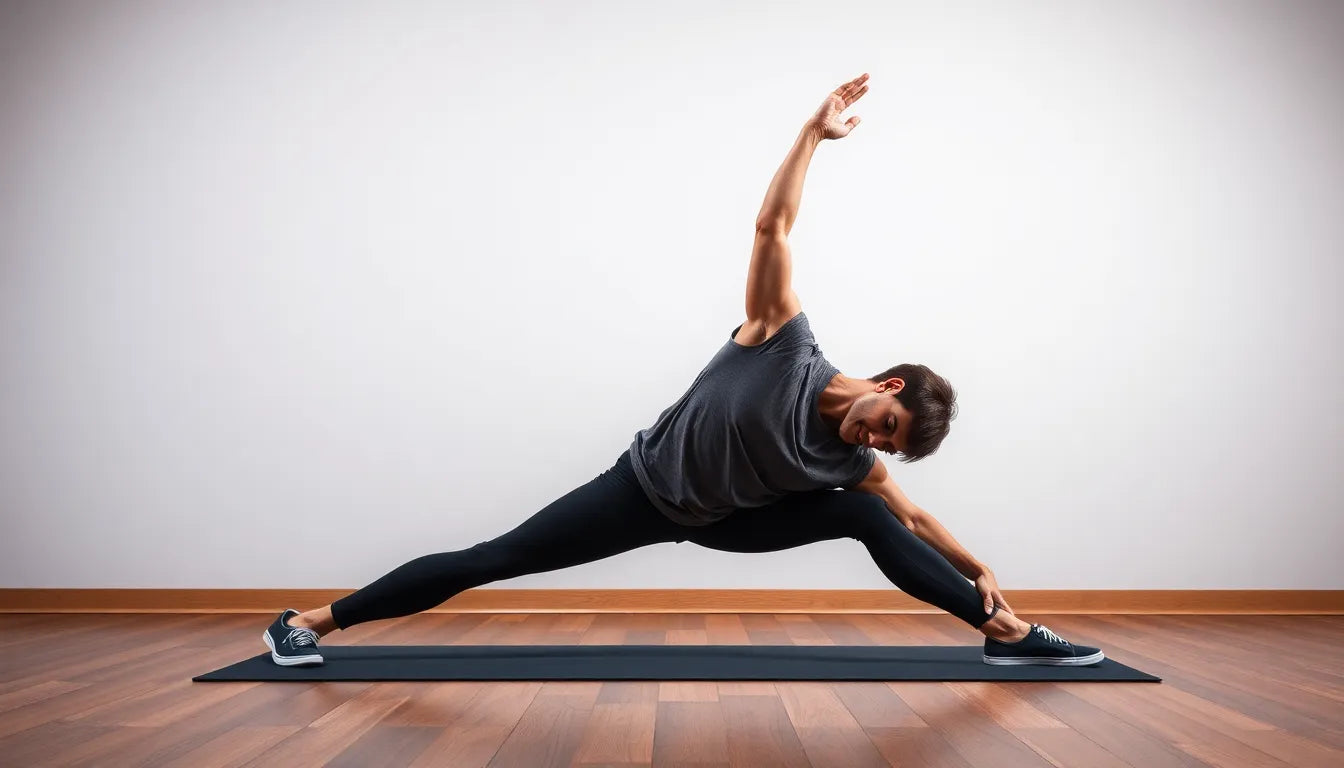Isometriske øvelser, or isometric exercises, are a form of static strength training where the muscles exert force without any joint movement. This type of exercise is commonly used to improve strength, stability, and rehabilitation, making it a versatile tool in fitness and health management. Unlike dynamic exercises that involve movement through a range of motion, isometriske øvelser focus on holding a position, which can be particularly beneficial for those looking to enhance their physical stability and strength without putting undue stress on their joints.
One of the key benefits of isometriske øvelser is their potential to reduce blood pressure. Studies have shown that these exercises can lead to significant reductions in both systolic and diastolic blood pressure, making them an excellent choice for individuals looking to manage their cardiovascular health. Additionally, isometric exercises are renowned for their ability to improve core stability, which is crucial for maintaining good posture and preventing injuries.
Why isometric exercises are gaining popularity
The growing interest in isometric exercises can be attributed to their effectiveness in enhancing physical performance and reducing pain. These exercises are particularly beneficial for improving posture, which is a common concern for many people, especially those who spend long hours sitting at a desk. By strengthening the muscles that support the spine and shoulders, isometriske øvelser can help alleviate pain and discomfort associated with poor posture.

Women's Posture Shirt™ - Black
Patented shirt stimulates muscle activity and helps relieve pain and tension, improving posture.
Moreover, isometric exercises are accessible and can be performed almost anywhere, without the need for specialized equipment. This makes them an attractive option for individuals seeking to incorporate strength training into their daily routine without the need for a gym membership. Whether you're looking to improve your physical fitness, manage pain, or enhance your overall health, isometriske øvelser offer a practical and effective solution.
Integrating isometric exercises into your routine
The primary intent of learning isometric exercises is to gain information and practical applications, especially for addressing concerns related to the neck, posture, and blood pressure. These exercises can be easily integrated into daily routines, providing a convenient way to improve physical health and well-being. For those interested in incorporating isometric exercises into their routine, it's important to start with simple exercises and gradually increase the intensity and duration as strength and stability improve.
In conclusion, isometriske øvelser present a valuable addition to any fitness regimen, offering a range of benefits from strength and stability to blood pressure management. By mastering these exercises, individuals can achieve pain-free living and enhanced physical performance, making them a worthwhile pursuit for anyone looking to improve their health and fitness.
Benefits of isometriske øvelser
Isometriske øvelser offer a myriad of health benefits, making them a valuable component of any fitness routine. One of the most significant advantages is their ability to significantly reduce blood pressure. A comprehensive meta-analysis has shown that isometric exercises can lead to reductions of approximately 8.24 mmHg in systolic and 4 mmHg in diastolic blood pressure. This makes them an excellent option for individuals aiming to manage hypertension and improve cardiovascular health.
Beyond cardiovascular benefits, isometric exercises are instrumental in enhancing overall strength and core stability. They are particularly effective at improving grip strength, which is crucial for daily activities and athletic performance. Furthermore, these exercises play a vital role in injury prevention by strengthening muscles and stabilizing joints, thus reducing the risk of strain and injury.
In the context of office ergonomics, isometriske øvelser are highly beneficial for improving neck and shoulder stability. They help counteract the negative effects of prolonged sitting and poor posture, which are common in office environments. By incorporating these exercises into daily routines, individuals can alleviate neck and shoulder tension, enhancing comfort and productivity at work.
Safety considerations for isometric exercises
While isometriske øvelser are generally safe, certain precautions should be taken to maximize benefits and minimize risks. One crucial aspect is maintaining normal breathing during exercises to avoid the Valsalva maneuver, which can increase blood pressure and pose risks, especially for individuals with hypertension. It's also advisable to start with graded exercises, gradually increasing intensity to prevent overexertion and injury.
It's important to avoid pain provocation during isometric exercises. If any discomfort or pain occurs, it's best to stop the exercise and consult a healthcare professional if necessary. By following these safety guidelines, individuals can safely and effectively incorporate isometric exercises into their fitness routines.
Programming isometric exercises for success
When starting with isometriske øvelser, a beginner’s routine might include holding positions for 5–10 seconds, performing 2–5 sets, and engaging in 2–4 sessions per week. As strength and endurance improve, more advanced practitioners can aim for holds of 10–30 seconds with submaximal pressure, tailoring the exercises to suit individual needs and goals.
Integrating isometric exercises into a regular fitness regimen can enhance overall strength and stability. For those seeking to incorporate these exercises into their routine, consistency is key. Regular practice will lead to improved muscle endurance, better posture, and reduced pain, contributing to a healthier and more active lifestyle.
Essential isometric exercises to try
Here are some effective isometriske øvelser to incorporate into your routine:
- Neck isometry (all directions): Sit straight and place your hand on your forehead, side, or back of your head. Press gently without movement for 5–10 seconds, performing 5–8 repetitions.
- Wall sit: Lean against a wall with knees at a 90-degree angle. Hold the position for 15–45 seconds, completing 3–5 sets.
- Plank/side plank: Hold a plank position for 20–60 seconds, progressing by lifting an arm or leg. Aim for 3 sets.
- Rotator cuff isometry: With your elbow at a 90-degree angle, press lightly against a door frame (inward/outward) and hold for 10–20 seconds.
- Grip isometry: Perform a farmer's hold or use a hand gripper for 20–40 seconds.
- Pause reps in squats/bench press: Pause for 2–7 seconds at the bottom or midpoint, completing 3–5 sets of 3–6 repetitions.
These exercises can be easily integrated into daily routines, providing an effective way to improve strength, stability, and overall health. By mastering these isometriske øvelser, individuals can achieve enhanced physical performance and pain-free living.
Integrating isometriske øvelser into daily routines can significantly enhance ergonomic health, particularly in office settings. For individuals who spend long hours at a desk, incorporating these exercises can help alleviate pain, improve posture, and prevent discomfort associated with prolonged sitting. Simple actions, such as performing neck isometries every 2–3 hours, can make a substantial difference in maintaining muscle endurance and joint stability.

Men's Posture Shirt™ - White
Patented shirt supports proper posture and helps relieve pain, ideal for daily use and exercise.
Isometric exercises are not only beneficial for rehabilitation but also for overall strength and athletic performance. They can be seamlessly integrated into existing fitness routines, complementing dynamic exercises and enhancing muscle activation. By combining isometric pauses and eccentric-isometric (EI) training with conventional strength training, individuals can achieve greater muscle engagement and improved physical outcomes.
Frequently Asked Questions
Is isometric training safe for individuals with high blood pressure?
Yes, isometric training can be safe for individuals with high blood pressure, provided the exercises are performed correctly. It's important to maintain normal breathing to avoid the Valsalva maneuver, which can elevate blood pressure. Studies have shown that isometric exercises can help lower resting blood pressure when done regularly and with proper technique.
Are isometric exercises only for rehabilitation?
No, isometric exercises are not limited to rehabilitation. They are also effective for enhancing strength, hypertrophy, and athletic performance. These exercises can be integrated into various training routines to improve muscle endurance and stability.
How can isometric exercises improve my office ergonomics?
Isometric exercises can significantly enhance office ergonomics by improving muscle endurance and posture. Regularly performing these exercises can reduce strain and discomfort from prolonged sitting, helping maintain a healthier and more comfortable work environment.
Can I integrate isometric exercises with other strength training?
Absolutely. Isometric exercises can be effectively combined with other strength training methods. Techniques like isometric pauses and eccentric-isometric (EI) training can complement dynamic exercises, providing greater muscle activation and time under tension, which are beneficial for strength and hypertrophy.
In conclusion, mastering isometriske øvelser can lead to pain-free living and improved physical performance. By incorporating these exercises into daily routines, individuals can enjoy the numerous health benefits they offer, from enhanced strength and stability to better posture and reduced pain. Whether you are looking to improve your ergonomic health or boost your overall fitness, isometric exercises are a valuable addition to any routine.
Kilder
- "Isometriske Øvelser: En Overset Nøgle til Styrke og Stabilitet." Styrketræningsprogram.dk.
- "NKR om Erhvervet Hjerneskade." Prodstoragehoeringspo.blob.core.windows.net.
- "Isometrisk Træning." Fysfinder.dk.
- "Idrætsskadebogen." Ballerupkampsport.dk.
- "Planken og Wall Sit er Bedst til at Sænke Blodtrykket." Videnskab.dk.
- "Clinical Trials Registry: Jumping Performance." ICHGCP.net.


















